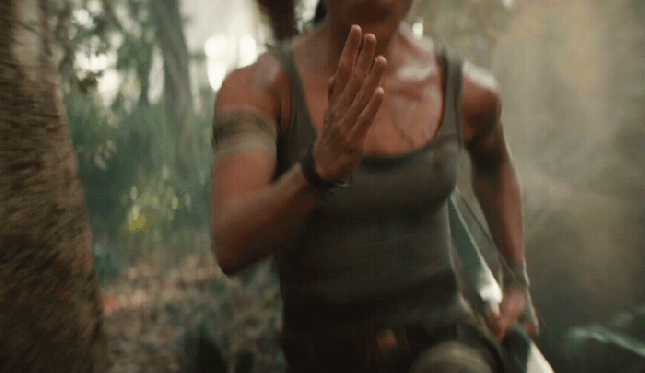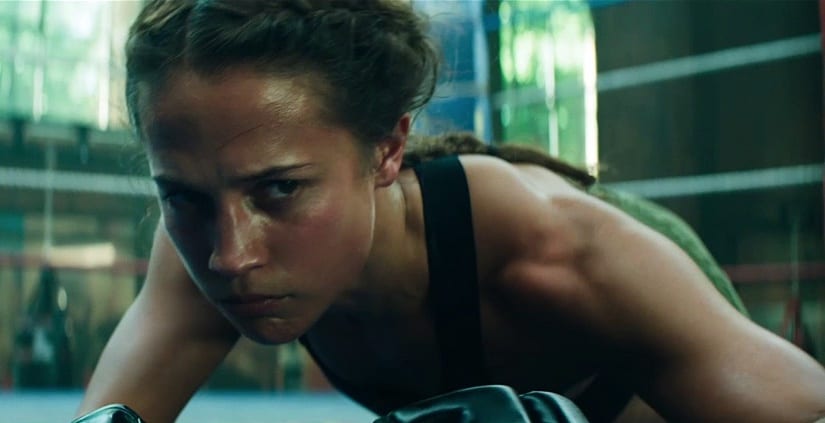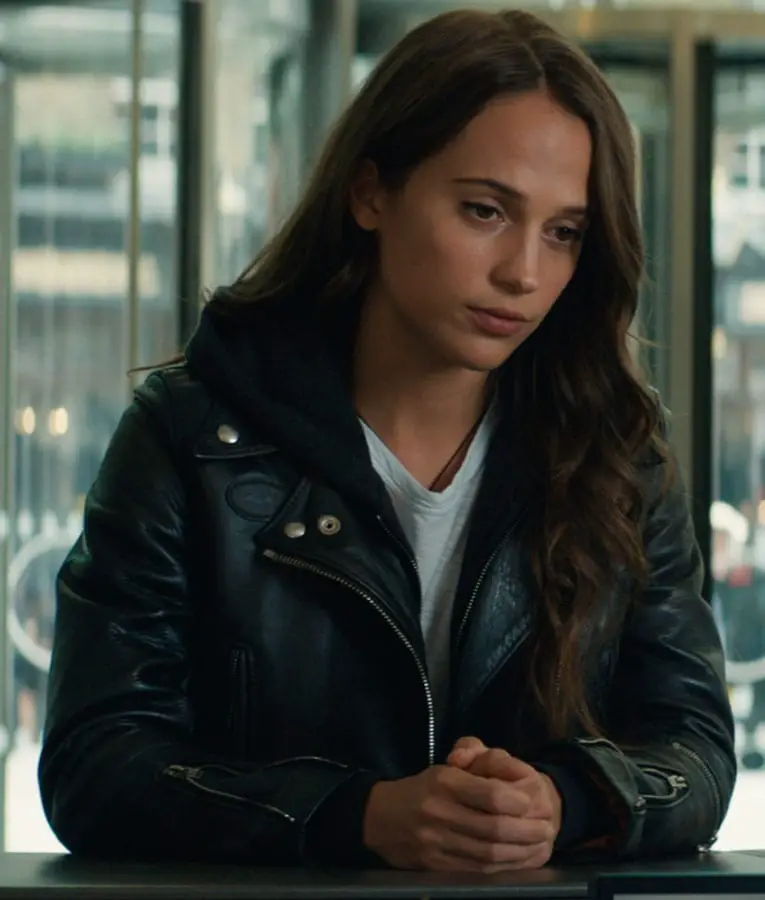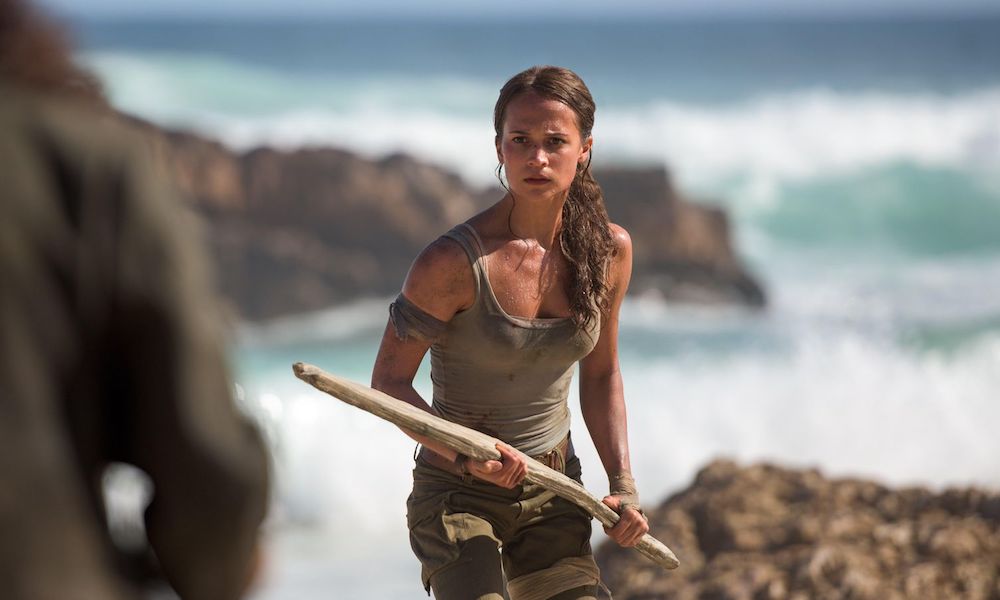And a sequel. Preferably more than one, but I’ll start with one.
There are a couple things I want to be clear about up front: I’m not here to argue about the merits of rebooting a film franchise based on a reboot of a video game. Nor am I particularly concerned with whether or not it the plot had holes (it does), or if the writing can be thin at points (it is), or how convenient/contrived certain aspects are (they are). Those are valid points. Though to my mind, I rather expect each of these to be true of films in this genre (see, the Indiana Jones, National Treasure, or Da Vinci Code film franchises).
What I’m interested in is Lara Croft as a character, specifically the version of the character portrayed in this most recent film by Alicia Vikander. I will admit, I haven’t played the new video game, so it may be they have a ‘better’ version of the character. That’s neither here nor there, though, because this isn’t about the game. This is about Vikander’s version and why we need to see more of her, and more female characters like her, on our film screens.
Her Strength and Intelligence
Vikander’s Lara might not be weight-lifter class, but she’s still physically strong. Most importantly, she’s strong in a way that’s appropriate for her body type. She reminds me physically of a cross between the rock climbers and distance runners I know, which is how the film showcases her strength. She’s fit without being superpowered for her size, and to my mind, her fighting style also fits naturally with her shape and size. Relying on her legs, exploiting her smaller size and maneuverability, taking advantage of distractions, not being afraid to ‘play dirty,’ utilizing grappling and choke holds—all this and more make her a believably strong woman for her size and skillset.

Plus, most of her physicality relies as much, if not more, on her intelligence, endurance, and fearlessness as it does on muscle tone or raw force. Dexterity and perseverance are just as important if you’re trying to weave through the jungle or freehand climb. And, she’s mentally strong enough to stare death in the face multiple times without blinking. Like a BAMF.
Like all archaeology-action movies, puzzles are a big part how Lara showcases her intelligence. While there are moments where I would have enjoyed a bit more explanation (the tomb combination for example), I’m not the kind of viewer who needs to follow along with every instance of puzzle solving. I get as much pleasure out of watching someone be clever without all the details of how it works. But we still get plenty of instances where we see Lara putting all the pieces together, even ones her father didn’t get.
She deciphers the color puzzle. She perceives the significance of the tomb murals and what they mean for Himiko (which is a big moment I’ll come back to). Her father tells her that she’s worth ten of him, and to my mind, she proves that. Was bringing the journal along with her the best choice in hindsight? Probably not. Then again, if she hadn’t, she never would have found her dad. She had no reason to believe that the ‘wrong hands’ were on the island with him. Making the most reasonable choice based on the information she had available to her doesn’t make her stupid. But that’s getting into plot contrivance, which as I said, isn’t really my concern. Besides, as anyone with ADHD will tell you (myself included) intelligence and common sense don’t always go hand in hand.
In terms of having a skilled action hero with believable physical abilities that are appropriate for her body type and size, mental endurance and perseverance, and critical thinking and problem-solving skills, Vikander’s Lara Croft delivers. The combination of physical and intellectual traits makes her a force to be reckoned with. She’s talented and we both want her to succeed and believe she will.
It’s the kind of film where I was unsurprised to find out that the screenplay was co-written by a woman (Geneva Robertson-Dworet, who went on to write the Captain Marvel screenplay). It shows.
Her Weakness and Vulnerability
Make no mistake, Lara’s physical and mental prowess does not mean she’s unbeatable. The very first scene of the film depicts her being beaten in an MMA-style fight. She gets stabbed in the gut and almost taken out by one of Matthias Vogel’s goons. She and Vogel have a pretty nasty knock-down, drag-out fight, and he does not take it easy on her.
Female action heroes have a tendency to either get taken out really easily, or never get hit in a way that would seriously wound them. They’re rarely ever allowed to get beaten up, which might sound like a good thing until you compare that to how much male action heroes are depicted as overcoming. Is it unrealistic at times? Yeah, but that’s how action movies work. The good guys get the shit kicked out of them, but they get up and keep going.

This kind of toughness and resilience is rarely ever afforded to female action stars who aren’t somehow ‘beefed up’ or superpowered. While it may not be intentional, one could reasonably walk away with the message that women are only capable of enduring that kind of physical stress if they have supernatural abilities. Lara doesn’t.
At the same time, the film doesn’t have to make allowances for her either. There’s no sense of ‘letting’ her win because she’s the protagonist or that she has to be ~objectively~ stronger in order to beat the men who attack her. She can take a punch, but she’ll throw one right back. And if a punch doesn’t work, a kick to the chest might.
Nor does the film require her to be emotionally stoic or withdrawn, the way many action heroes (both male and female) are. She’s clearly wounded by her father’s disappearance without it becoming too much of a toxic chip on her shoulder. It’s a driving motivation without becoming an excuse to for her to lash out or shut down her emotions entirely.
This version of Lara is emotionally textured in a way I didn’t expect to find. She can stare down death at one moment, and weep over finding her father again the next without them being contradictory. She feels deeply without it being a weakness. It helps that Vikander’s face acting is so engrossing. (If you want emotional face journeys, this is a film for you.)
I also appreciate how accurately the film portrayed her reaction the first time she kills someone, and that she was given the space to have that reaction. Again, she’s given room to be vulnerable, but in a way that makes her relatable and emotionally layered. If her strength makes her admirable and worth cheering for, her vulnerability makes her human.
Her Resilience and Adaptability
Vikander’s Lara doesn’t survive because she’s untouchable. She has grit. One could argue that two of her best skills are her resilience and adaptability. She just never gives up no matter what. She gets kicked down, but she gets back up. She uses her enemies’ moves against them and learns from her mistakes. She sees and exploits weaknesses and is willing to change her plans based on changing circumstances and her fighting style based on her opponent.
It isn’t just physical either. As with all of her traits, her emotional resilience matches her physical perseverance. She definitely wasn’t in the greatest place emotionally when the film started, but she wasn’t in full self-destructive mode either. By the time the film ends, we’ve seen her go through an emotional roller coaster, yet we know she’s stronger for it.
Let me tell you, as a woman who has been through some pretty heavy shit in my life, seeing a female character display the kind of physical and mental toughness Lara has without losing her emotionality inspires me. I (hopefully) will never have to physically fight with dudes who want to unleash a horrific biological weapon on the world. But her refusal to give up, to literally rather go down fighting than drown in her pain or let corrupt people do horrific things, speaks to my emotional suffering on a metaphorical level.
She displays the kind of endurance I aspire to. And it’s great to see a female action hero embody that because this is a genre I grew up on but rarely got to see myself represented in. I want little girls to see her and think, “I can be that tough, too, and still be vulnerable without either one undermining the other.”
The Lack of Male Gaze
When it comes to her body shape, Vikander’s Lara looks nothing like the original game character or like Angelina Jolie, who played Lara in the 2009 film. Alicia Vikander herself has said that her breasts “are not as pointy as the first Lara”—a fact that I have seen bemoaned by many (mostly men) on the internet and social media.
But that isn’t the only thing that makes her, and this film, different from her predecessor. This Tomb Raider evinces a distinct lack of the male gaze throughout. Lara’s clothes are appropriate and fit her without being overly revealing. (Sorry, guys, no silver catsuit to show off every curve.) She’s actually dressed like someone who plans on strenuous physical activity (bearing in mind her boat capsizes and she loses all her clothing except what she’s wearing). Her non-adventuring clothing is likewise functional but not eroticized. I dig the soft butch aesthetic they gave her.

The camera never lingers and her fight choreography is far from sexy or sexualized. The film pulled off the impressive feat of opening with an MMA-style fight between two female characters without the fight looking like it belonged in an adult film. No booty shorts and no gratuitous shots of her girls or booty while she’s sparring? No catsuits with visible ass crack and an inexplicably plunging neckline? No lingering shots of her wet shirt clinging to her body? No moaning that sounds suspiciously like an orgasm or ‘girly’ yelps that sound as much from pleasure as from pain?
Can I believe my eyes, or is this a female action hero being treated as more than eye candy?
For a franchise that most would associate with the objectification of its female protagonist, there is a refreshing avoidance of it with Vikander’s Croft. The one moment where she’s called ‘pretty’ comes from the creepy villain, and she (and the audience) justifiably recoil from it. Because it’s creepy and gross for him to comment on her like that (especially in context). If that isn’t a rejection of her objectification nothing is.
Yes, Alicia Vikander is physically attractive. But the film doesn’t make her story or her role as the protagonist about that. Nor does it make it about her being or having a romantic interest. There’s space to ship her and Lu together, for sure, but it’s never explicit. In fact, the film does everything it can to make this a character driven story and her character does not revolve around her attractiveness. She’s not presented for objectification by the male gaze the way other iterations of Lara Croft have been. It’s one of the things I love most about her, but I do suspect it pisses off a certain subset of viewers.
Her Privilege and the Reclamation of History
I didn’t go into the film expecting a lot of thematic resonance, and to be fair, it isn’t foregrounded. As I said, this is primarily a movie about the character of Lara Croft and her journey to find her dad. It’s a hero origin story, only instead of a superhero coming to terms with her powers, we get a woman accepting and finding her place in her father’s (true, secret) legacy.
Yet, within that story of accepting that her father had a secret life as an eccentric explorer and researcher of the supernatural is one of privilege and responsibility. Ana Miller wants Lara to ‘claim her inheritance.’ Lara refuses to do so because it would mean declaring her father dead in absentia. Yet Lara also declares that the money isn’t hers; she’d rather make her own way in the world than use her father’s money. There’s a nice metaphor there for a child of privilege not wanting things handed to them that they didn’t earn.
Am I making too much of it? Maybe. But the film explicitly draws the connection between the Croft wealth and having a societal responsibility to do the right thing more than once. Her father tells her as much, though she doesn’t understand until after she’s learned about Trinity and sees firsthand the lengths to which they would go to harm others in their attempt to, as Richard Croft puts is, “control humanity.” We don’t know precisely how this would work or what they plan on, but they were willing to hunt down and utilize a bioweapon of mass destruction so…we know they’re pretty darn evil.
As someone with wealth and connections, Lara has the resources and privilege to take Trinity on. Should Tomb Raider get a sequel, I have little doubt this would be part of it; the ending to the film makes this pretty well explicit.
And let’s not forget that moment where Lara realizes how much history had gotten wrong about Empress Himiko. It may seem like an offhand moment, but she literally recontextualizes the historical record, reclaiming the truth behind the myth. The legends about Himiko had quite literally demonized her and transformed her story of self-sacrifice into one of male rebellion and deliverance from an ‘evil, destructive’ female ruler. Lara sees the slanderous lies for what they are and calls them out. It may be small, but she gives Himiko a moment to be seen for what she was: a leader faced with a hard realization who chose to die to save her people from a disease she had no power to end.
As someone who cohosts a podcast dedicated to shining a light on the underappreciated and overlooked queer folks in history, I can appreciate just how important this kind of moment is. She’s reclaiming history for a woman who had lost the ability to speak her own story. A woman whose choices had been demonized by the (presumably male) writers who passed her story down in its distorted form. The film didn’t have to include this, but it did. And that’s significant.
Most archaeological adventure movies include a layer of colonialism and exploitation of native cultures, even by the good guys. Here, only the baddies seek to remove artifacts from their original context. While I can’t say Lara tries overly hard to preserve the original context, she’s the only one to see and embrace Himiko for what she was—a leader who sacrificed herself to save others—rather than being a symbol (Richard) or a weapon (Trinity). Thus, embedded within this adventure story of a woman finding her long-lost father is the reclamation of female history and sacrificial leadership.
Bringing this back around to Lara’s sense of responsibility, she finds out that Trinity’s front company is owned by Croft Holdings. She and her father have been benefiting from a corrupt system this whole time and she never knew. Yet as soon as she finds this out, she takes it upon herself to see just how far it goes and is quite ready to bring the whole thing down, even if it adversely affects her. She’s seen Trinity’s brutality and corruption first hand and is unwilling to let more people suffer.
When you put it like that, it’s a pretty good analogy for using privilege to bring down unjust and corrupt systems. With her position comes a responsibility to protect the world and others as much as she can and do her part to bring the system down. What I’m saying is, it works really well as a “fuck the patriarchy” metaphor. That may not be the intent, but it works pretty damn well. So well that I’m inclined to think that it was intentional but intentionally subtle.
So…What’s the Big Deal?
So Alicia Vikander’s portrayal of Lara Croft is emotionally and mentally textured. So she’s given space to be both strong and vulnerable. So she has great acting chops and a strong face-journey game that is at once powerful and understated. So the character has one moment of reclaiming a female figure from history and goes on to use her newly acquired wealth and privilege to bring down a corrupt organization she unknowingly benefited from as a child. So what? Why does that mean we need more of her and female action heroes like her?
For one, because she’s uniquely human and relatable as a female action hero. She’s neither idealized nor sexualized. She’s resilient, adaptable, and clever—character traits that men, women, and enbies of all ages can look up to. She avoids falling into toxically masculine tropes like emotional repression, lashing out, or revenge-fueled violence.
She’s the kind of adventurer you can see rescuing artifacts from those who would exploit or weaponized them and restoring them to their original contexts. Now, she may never do that, but it fits with her character to do so. Unlike an Indiana Jones or Benjamin Franklin Gates, she’s not a treasure hunter masquerading as an archaeologist. As enjoyable as such films are, I’m ready for the genre to evolve. In today’s cultural context, films that highlight the exploitation that lies behind digging into the past and other cultures would be a welcome commentary on how colonialist most of Western archaeology has been.
Granted Lara Croft might not be the best female action hero for the role, given that she’s white and Western herself. However, a character like Vikander’s Lara can create space for another female action hero, one played by a woman of color, to come along and do so.
If Lara gets to be a multi-faceted character who kicks ass and displays emotional vulnerability while taking down a big business and reclaiming some female history along the way? So much the better. I’m here for it.
